 By Staff By Staff
January 14th, 2022
BURLINGTON, ON
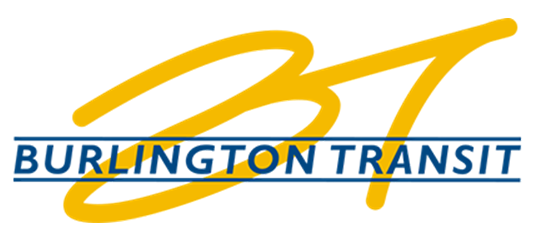 Starting Monday, Jan. 17, 2022, the Downtown Terminal opening hours will be Starting Monday, Jan. 17, 2022, the Downtown Terminal opening hours will be
- 8 a.m. to 4:30 p.m. on Monday, Tuesday, Wednesday and Friday
- 9 a.m. to 6 p.m. on Thursdays and
- 10 a.m. to 2:30 p.m. on the last Saturday of the month
Customer service can be reached in person at the Downtown Terminal, 430 John St., by phone at 905-639-0550 or by email at contactbt@burlington.ca.
This service level follow policies and protocols in place to prioritize the health and safety of our staff and our residents. We ask for your patience and understanding.

 By Paul Sharman By Paul Sharman
January 14th, 2022
BURLINGTON, ON
The following response to residents of Burlington who have emailed City Council members regarding the potential increase in urban boundaries in Milton and Halton Hills.
Thank you for your email regarding release of land for housing in the new Region Official Plan leading to 2051. I respect and understand your concerns. I and my Burlington Council colleagues have received hundreds of emails from Halton residents in response to the campaign initiated concerned residents. I am only addressing this subject from the perspective of Burlington in this response.
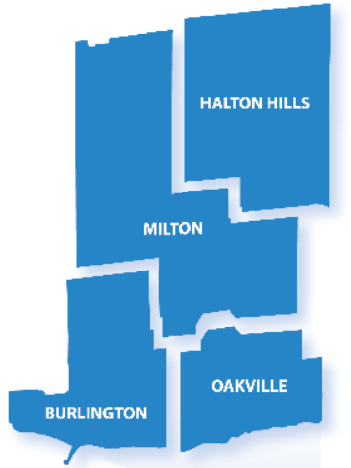 Nothing in the Region will be able to open up – maybe next week. Both Region and City members of Council are committed to maintain rural Burlington as it is. There are no plans to allow housing in our rural lands other than as is currently permitted. Release of land is proposed by the Region in Milton and the Halton Hills only, not Burlington.
Official Plans (OP) have extensive analysis and regulations to ensure existing protection remains in place. You will find OP details for Burlington here https://www.burlington.ca/en/services-for-you/Official-Plan.asp
This is a challenging issue for us all. There are a number of factors that have to be considered:
The first is that the Region of Halton is obliged to craft a plan that satisfies the province’s 1.1m population requirement by 2051.
The second is that the Region must provide substantiation that the plan will satisfy market demand. Scenarios 3a and 3b, which have been considered, provided for significantly greater % of apartment units and very few ground oriented homes than other scenarios and could not satisfy the market test. Indeed, the recent preferred scenario is barely representative of anticipated demand. Keep in mind that Canadian dream is to live in a house with a garage and a yard, as you will understand. The preferred solution is a compromise.
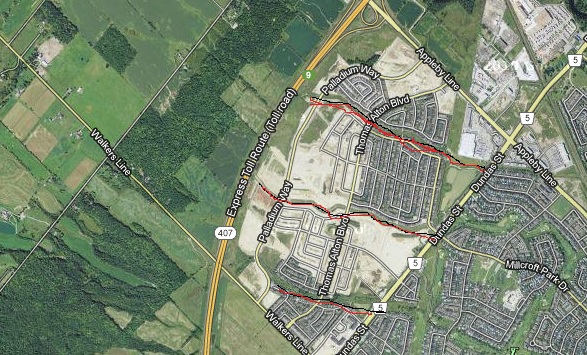 Hwy 407 and Dundas Street are the northern boundaries for development in Burlington. The Alton community would never have come into being were it not for the building of the 407 highway. That decision opened up land that was part of rural Burlington. Alton Village is bounded by the 407, Walkers Line on the west and Appleby Line on the east with Dundas making up the southern boundary. The third is that because Burlington is essentially built out, we receive all residual population growth that cannot be accommodated in Oakville, Milton and Halton Hills in what ever scenario is selected. In scenario 3a and 3b, that would mean in excess of 80,000 new residents moving into Burlington by 2051, like it or not.
Because Burlington is essentially already built out, under scenario 3b, Burlington will have no other choice but to to accommodate about 90% of new residents in 200/300 mid to high rise apartment buildings.
That would happen in 5 strategic growth areas of Appleby GO, Burlington GO, Aldershot GO, Up Town (Upper Middle Road and Appleby Line) and Downtown Burlington. We do not know what the distribution of those apartment buildings will be yet, but it certainly means significant densification of all five locations. It creates a tenuous outlook for all five, including downtown, by the standards of most Burlington residents.
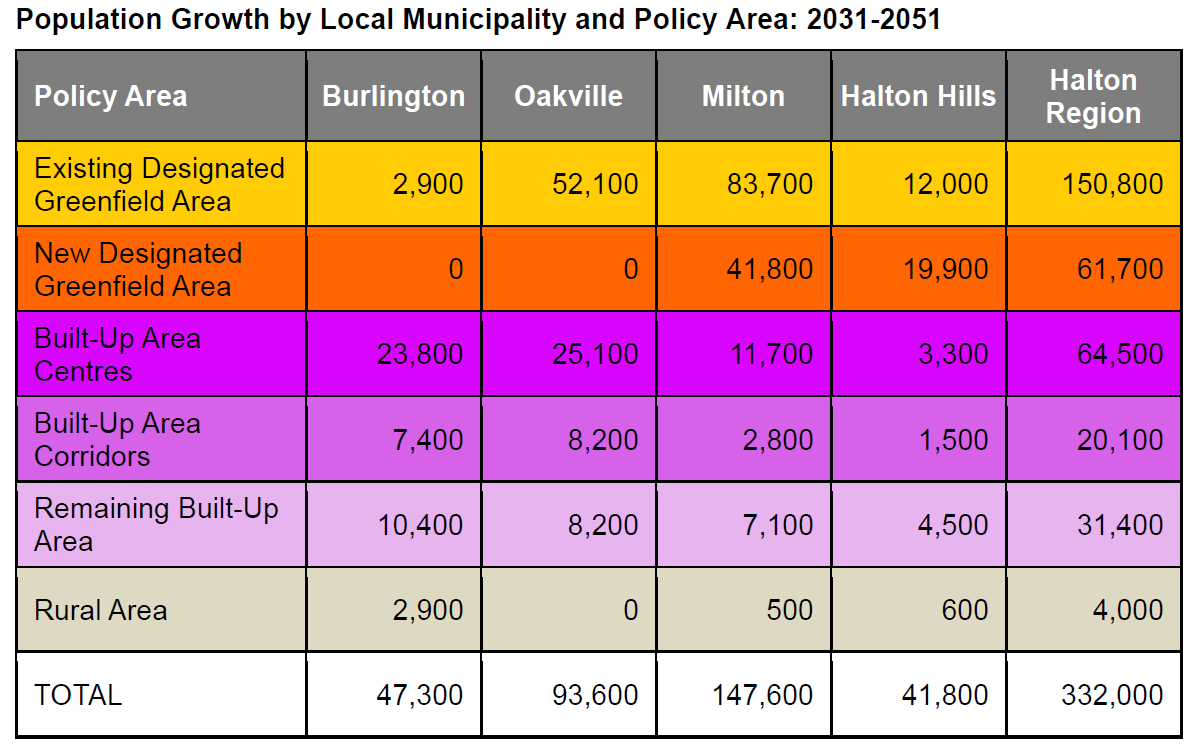
The preferred scenario; 1) satisfies Provincial tests to accommodate foreseeable market demand, providing homes for a small number of families who wish to live in a home with a backyard and a garage. That means the Province will likely approve the plan, but not 3a or 3b; 2) increases the number of people who will live in newly constructed apartments representing about 60% across the Region, but more like 90% in the City of Burlington, which is essentially what you are advocating for. Reducing the Burlington allocation to 70,200 population lowers the number of apartment buildings by 25 to 37.5 buildings, providing a bit of a breather to the community. Please take a moment to visualize what the Burlington skyline, living conditions and congestion is likely to become, even under the preferred scenario.

 Keep in mind, this plan follows the 2018 election when the people of Burlington spoke out clearly that they do not wish to see “over intensification” of their hometown. It is not what anyone wanted. Keep in mind, this plan follows the 2018 election when the people of Burlington spoke out clearly that they do not wish to see “over intensification” of their hometown. It is not what anyone wanted.
In any event, the City will experience increasing numbers of apartments not only between now and 2051 but even more for years too come. The same will be true for the other Halton municipalities. The preferred scenario simply delays inevitable further densification of Halton.
I will be pleased to discuss this with you if that will help.

 By Pepper Parr By Pepper Parr
January 14th, 2022
BURLINGTON, ON
Ryerson Park was to be renamed.
Egerton Ryerson was no longer in fashion and the Mayor saw merit in renaming the park, which was adjacent to the elementary school of the same name.
Based on a Motion brought to the Standing committee, the recommendation was to approve Sweetgrass Park as the new name for the park formally called Ryerson.
In July of 2021 council supported a Motion Memorandum from the Mayor which included the following staff direction:
Direct the Director of Recreation, Community and Culture to initiate the renaming process for Ryerson Park in keeping with our naming policies, ensuring equity, diversity and inclusion is reflected in the new name, and report back to committee with a recommendation for a new name by November 2021.
Staff completed a three-phase engagement process with the Community and worked with a small group comprised of the Chair of the Inclusivity Committee,
 Stephen Paquette Stephen Paquette, resident and Indigenous elder, ward Councillor Shawna Stolte, and Denise Beard, Manager of Community Development were named to the committee to review community suggestions. The Trustee for the ward also attended the meeting to observe the process.
Using the Naming of Corporate Assets Policy, the small group reviewed the policy to determine which criteria would be weighted higher than other items. For example, the group felt that a name that reflected a sense of place and supports diversity and inclusivity, was more significant than honoring a person, persons, a family group living or deceased who have made a significant contribution to the community.
 A field of sweetgrass After coming to consensus of the evaluation matrix, and streamlining the list of names to remove duplications, or names that violated the policy, each member of the small team completed an individual rating and ranking of the suggested names.
At a consensus meeting the small group supported the following themes
Head of the Lake Park
Unity Park
Truth and Reconciliation Park
It was through that discussion that Stephen suggested a pause to consult with an Indigenous linguist to see if there was an appropriate Indigenous word that might best reflect the theme. Also, during the same discussion, Paquette educated the group on “Sweetgrass”, one of the sacred medicines to many First Nations. It is used as a purification medicine in ceremony to purify ourselves and to heal.
 Single strands are not very strong but when woven together the grass is very strong.  Many indigenous communities weave baskets out of sweetgrass The planting and use of sweetgrass is widespread by most Indigenous cultures in this area. This transcendence and the use of sweetgrass resonated with the group.
After the meeting Stephen sought the advice of an Indigenous linguist to find the right word. Sweetgrass was added to the list of names.
Community voting took place through the Get Involved page on the city web site. Over 1,600 votes were cast by Burlington residents.
The results are:
 Heat map showing where the cotes for the new park name came from. Name Percentage of Votes
Head of the Lake Park 16.1%
Unity Park 39%
Truth and Reconciliation Park 5%
Sweetgrass Park 40%
Committee had many options to consider:
- Use the most voted name by the community which supports the community engagement process.
- Combine the most popular names for example – Sweetgrass Unity Park.
- Give the park the same as the recently announced re-named school
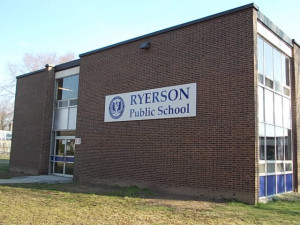 Ryerson Public school has been renamed Makwendam Public School. Makwendam Public School. Pronounced muck-kwen-dum, the Indigenous word for “to remember” in the Anishinaabemowin language.” This would provide consistency between the two properties but did not honour the public engagement process.
Replacement signage reflective of the truth and reconciliation – speaking about the past and why the name change and the City’s aspirations for Truth and Reconciliation by re-naming the park – would cost about $5,000.
 Despite creating the system of publication education in Ontario Egerton Ryerson has been set aside to make room for a much needed change in the public acceptance to the damage done at residential schools operated for the most part by Christian churches Staff are also looking at the installation of a medicine wheel or healing circle in the park as well as sweetgrass plantings. Staff have had some preliminary discussions with a potential donor to support the capital investment for the medicine wheel or healing circle. The donor would look for their donation to be matched by the City.
More than 500 suggestions were submitted; once whittled down to four names, the community cast over 1,600 votes

 By Staff By Staff
January 13th, 2022
BURLINGTON, ON
An outbreak has been declared on Unit 4 North 700 (4N700) at Joseph Brant Hospital (JBH) after five patients tested positive for COVID-19.
All appropriate precautions have been taken to ensure the safety of patients, Essential Care Providers (ECPs), staff and physicians.
This is the second Covid19 outbreak announced by the hospital in the past ten days.
Joseph Brant Hospital’s Infection Prevention and Control team and Employee Health Services are ensuring all patients on the unit, along with staff and physicians who have been or may have been exposed, are being contacted, monitored, tested as required and self-isolating in keeping with Public Health guidelines. Patients on the unit are in isolation as of January 11 and have been instructed to continue the 10-day self-isolation when discharged from hospital.
A number of enhanced safety measures are in place to prevent the spread of COVID-19 and ensure the safety of patients, staff and physicians. This includes closing 4N700 to new patient admissions. In addition, ECPs are no longer permitted to enter the unit except under exceptional circumstances in consultation with the patient’s care team. Patients can still connect with their loved ones by telephone and video – both telephone and WiFi are available at no cost.
JBH is monitoring the situation closely and will continue to work closely with Halton Region Public Health to bring a safe end to the outbreak as soon as possible. Patients or loved ones who have questions or concerns can contact a member of the JBH Patient Relations team at 905-632-3737 ext. 4949 or by email patientrelations@josephbranthospital.ca.
Related news story
Covid19 outbreak on unit 6 SOUTH at JBH

 By Mike Collins-Williams By Mike Collins-Williams
January 13th, 2022
BURLINGTON, ON
The West End Home Builders’ Association is very pleased to participate in the City’s Housing Strategy Working Group. I’ve been very encouraged by the discussions from this diverse group who bring different life and professional experience to the table.
I want to open my comments by acknowledging the housing challenges we face not just in Burlington, but across this entire metropolitan region that is the fastest growing area in North America. In fact – numbers were just released that Canada grew by over 400,000 people in 2021 and for the first time in Canadian history – Canada’s population growth exceeded that of the United States – a country 9 times larger.
Understandably, most of the new growth is coming to Vancouver and the GTA – and we here in Burlington are experiencing the pressures of this growth and the escalating cost of housing due to the inability of housing supply to keep up with demand.
 There is no silver bullet solution to the housing crisis. We all need to work together – The private sector, the non-profit sector and all three levels of government. I strongly believe that this is the most important opportunity to develop the effective partnerships we all need to successfully address the housing crisis. There is no silver bullet solution to the housing crisis. We all need to work together – The private sector, the non-profit sector and all three levels of government. I strongly believe that this is the most important opportunity to develop the effective partnerships we all need to successfully address the housing crisis.
I am happy to be here today to talk about one planning tool that is available to us – and that is inclusionary zoning.
I’m happy to see the time and energy Burlington is investing to analyze housing options intended to promote much needed public policy adjustments through the Housing Strategy. I am here to say to you today as the CEO of the West End Home Builders’ Association that we support the development of mixed income communities, and we are supportive of the use of inclusionary zoning as a planning tool – but we need to make sure it’s done right and within the context of a comprehensive and achievable housing strategy.
There are over 800 examples of inclusionary zoning across North America – some jurisdictions have well designed policy frameworks that support the construction of new affordable units without placing the burden of costs onto the other buyers or renters through cross subsidization… while other jurisdiction have models that don’t effectively generate much of any affordable housing, and others thrust the entire cost of the program onto other purchasers
If Burlington’s Housing Strategy cares about providing housing in Burlington for all income levels, then we as a society have an undeniable role to play. We must collectively pay the costs of constructing affordable or subsidized housing options. This burden should not just be on new home buyers, but on everyone from a shared tax pool which can support the costs of an IZ program.
New first-time buyers of entry level condos near Burlington’s 3 GO Stations and renters absolutely should not be burdened with the entire cost of building affordable housing. Prices are already too high and asking first time home buyers to cover the cost of an affordable housing program is unequitable, unfair and socially irresponsible.
Our members have the knowledge, experience and capacity to build more housing – especially more transit-oriented and energy efficient multi-unit mid-and-high rise buildings in mixed income communities
surrounding Burlington’s GO Stations. This is a huge opportunity for the City of Burlington to partner with the private sector to provide affordable housing units that would otherwise not be built.
Here are a few suggestions for Council to consider as it researches and develops policy options:
Consider early in the policy development stage who will own, manage and maintain affordable units and administer an inclusionary zoning program. We recognize and appreciate that this was identified in Appendix A of the staff report.
As we are still in the earlier stages – we want to ensure that we don’t end up with an overly complex program with overwhelming administrative challenges. This is a particularly important consideration for the City of Burlington due to its size and the quantum of new affordable units that can reasonably be achieved.
I also want to highlight what type of housing inclusionary zoning can effectively deliver – I like to use the British term “workforce housing” – inclusionary zoning is not a silver bullet that can deliver either deeply affordable housing or supportive housing where additional services and financial support are required.
What inclusionary zoning can deliver, if designed properly, is key “workforce housing” within an affordability band just below where the market is today to provide a helping hand to folks that are struggling to get into the market.
As part of the Municipal Comprehensive Review currently underway and to assist the City’s efforts to satisfy its future growth requirements, the city also needs to consider and facilitate and environment that enables the City of Burlington to maximize the growth potential of its 3 PMTSAs.
Given the limited amount of MTSAs in the City, and the amount of growth likely to be allocated to the City, it is especially important to ensure that IZ units are “additive” to the supply that the market would provide in the absence of IZ.
Therefore – we need to ensure that an emphasis is placed on economic viability for those transit station areas under consideration in Burlington.
A poorly designed program won’t actually yield any affordable units and will increase the cost of entry level market-housing for first time buyers and renters.
A poorly designed program also runs the risk of causing Burlington to miss those targets and displace projected growth to other communities in other Burlington neighbourhoods or to adjacent communities that do not have the infrastructure necessary to support growth.
Any inclusionary zoning policy must be built as a true partnership and paired with offsets necessary to ensure the success of the program.
The industry is not seeking direct subsidies – but rather an intuitive partnership where the City of Burlington is not levying tens of thousands of dollars of costs through development charges, cash-in-lieu of parkland fees, underground parking requirements etc – on units that we are trying to ensure are affordable.
We need a partner to make this work – and we believe that with your help we can make this work to build more inclusive communities.
We are also hopeful that we can work together with the City of Burlington to leverage and potentially stack benefits through any provincial programs or through funds or low-interest CMHC loans that may be available from the Federal Government through the National Housing Strategy.
The more coordinated we are in our approach – the more benefits we can deliver.
I encourage Council members to review the case studies that are being generated. We should all have a good understanding of unsuccessful inclusionary zoning programs to understand the pitfalls of poorly designed programs.
We also need to pay attention to the case studies for comparable cities – Burlington is not Toronto, New York or San Francisco – we are not producing tens of thousands of units per year – nor do we have State programs like the 421A in New York where property taxes are waived entirely in rental buildings with affordable units or National programs like to Low Income Housing Tax Credit offered in the States – there are more senior level of government programs down there that can be combined into Inclusionary Zoning programs to support economic viability… I hope that is acknowledged as we move forward in Burlington to make sure we are working together to design an effective program.
I want to close by saying that in 2021, WE HBA has been pleased to see renewed collaboration between ourselves and the City. I sincerely appreciate my appointment to Burlington’s Housing Strategy Task Force and believe we are making positive progress. I am hopeful to continue in that positive direction and spirit of collaboration in any future work on Inclusionary Zoning.
 Mike Collins-Williams is the CEO of West End Home Builders Association (WEHBA) . He is a Registered Professional Planner and is a member of the Burlington’s Housing Strategy Task Force Mike Collins-Williams is the CEO of West End Home Builders Association (WEHBA) . He is a Registered Professional Planner and is a member of the Burlington’s Housing Strategy Task Force
WEHBA is the organization that represents the interests of the construction and developer interests.
Related news story:
What is inclusionary zoning.

 By Don Fletcher By Don Fletcher
January 13th, 2022
BURLINGTON, ON
An earlier version of this article included illustration that were out-dated. The illustrations have been revised.
We are pleased to learn from this update that Phase 4 of this study has restarted, and to understand somewhat why the study was placed on hold in mid-2018. Given that we’ve suffered through a pandemic over the last few years, it’s understandable why it wasn’t resumed earlier.
 A study on the best way to develop this area began in 2015. The delay in completing the Waterfront Hotel Planning Study as originally planned is still potentially problematic. In Section 3.3 of Bousfields’ Planning & Urban Design Rationale that was part of the Burlington 2020 Lakeshore Inc.’s development application submitted on October 26th, 2021, their rationale for requesting the removal of Policy 5.5.9.2(l) of the in-force Burlington OP, as amended, was that this study had an “indeterminate deadline” with a further characterization that it “has never been completed, indefinitely sterilizes the subject site from redevelopment and from achieving its highest and best use potential”. It is not clear to us whether the property owner ultimately plans to ignore the guidance of the Waterfront Hotel Planning Study, but it is clear that completing it on a highly accelerated basis must be a top priority.
Citizens’ PLAN B remains committed to the extension of Spencer Smith Park and the enhancement of the Brant Street gateway to Lake Ontario, through the application of the ‘Thin Red Line’ design principle related to the Waterfront Hotel Redevelopment. Yes, we understand the changing context of the NE corner of Brant Street & Lakeshore Road with respect to the origins of the ‘Thin Red Line’, but it still has great utility in its’ application to achieve what most residents want in the redevelopment of the Waterfront Hotel property and remains a simple concept that resonates with everyone.
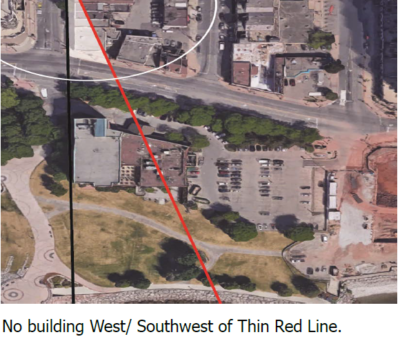 A citizens group – Plan B – introduced the concept of a thin red line. Will it be enough and will it ever be adhered to? We understand that City staff with support of project consultant, The Planning Partnership, will resume the work plan where it left off in 2018. This update references Section 3 of Report PB-23-18, which contains 16 key policy directions, as one of those milestones that can be built upon.
PLAN B fully supports PB-23-18.
Application of the ‘Thin Red Line’ will help fulfill Public Realm policy directions 5a, 7, 8 and 9, which in our opinion are not achieved in the current development application.
One deliverable that was not mentioned in this report but should also serve to expedite completion of the project is Emerging Preferred Concept #3. I have attached a Planning Partnership Jan/ Feb 2018 Overview/ Snapshot of its’ evolution for your reference, with some of the rationale for selecting EPC #3 noted there re-iterated below:
Achieves the Urban Design objectives for the Downtown
Achieves a Floor Area Ratio (FAR) that balances the base permissions of 5.0 with the Developer’s Current Concept of 7.5 FAR
Buildings located east of the ‘Thin Red Line’, representing the view corridor south of Lakeshore Road, proposed by the Downtown Mobility Hub Study. A new significant open space defined by the ‘Thin Red Line’ located on the west portion of the property, contiguous with the waterfront park
Buildings that provide a clear landmark visible from the park, Brant Street, John Street, Lakeshore Road & Lake Ontario
A potential development yield that is viable and provides some incentives for redevelopment.
 Panel 1 is what the developer originally proposed, panel 2 is what is permitted on the site, panel 3 is one of the alternatives that didn’t include any resident input panel 4 is the last iteration of concepts being considered in the planning study. This was the last iteration of conceptual designs that we were party to, and while we fundamentally supported it, we through Ramsay Planning Inc. submitted a few minor improvement suggestions. We are unaware of Vrancor’s feedback.
We acknowledge and respect the current property owner’s right to profit from his investment, and that this will necessitate a “reasonable” amount of massing and building height. We also believe passionately that the impact of this development will be felt by many future generations of Burlington residents & visitors, and collectively we must get it right. Citizens’ PLAN B is completely open to work with all stakeholders to help make this a “win-win” scenario.
Follow Plan B at: www.planbwaterfrontredevelopment.ca
Related news stories:
What about a land swap?
Plan B has been pressing city council for years

 By Staff By Staff
January 13th, 2020
BURLINGTON, ON
Burlington is going to hear a lot about Inclusionary Zoning. Most council members love the idea and the Mayor is going to make it a key plan in her re-election campaign. It might help if the public knew just what Inclusionary Zoning is.
What is Inclusionary Zoning?
Inclusionary zoning (IZ) is a policy tool available in many jurisdictions across Canada, the United States and beyond. Generally, Inclusionary Zoning is a policy tool that can be used to mandate or incentivize developers to provide affordable housing units. In Ontario, Inclusionary Zoning is a planning tool that enables municipalities to secure affordable housing units as prescribed in the Planning Act.
 Section 16(4) of the Planning Act contains express permission for municipalities to implement Inclusionary Zoning under the provisions as outlined in Section 35.2 of the Planning Act. These provisions have existed since 2016, when the Province of Ontario passed the Promoting Affordable Housing Act, 2016 (through Bill 7). Since then, there have been a number of legislative and policy changes that have impacted the implementation of Inclusionary Zoning. Section 16(4) of the Planning Act contains express permission for municipalities to implement Inclusionary Zoning under the provisions as outlined in Section 35.2 of the Planning Act. These provisions have existed since 2016, when the Province of Ontario passed the Promoting Affordable Housing Act, 2016 (through Bill 7). Since then, there have been a number of legislative and policy changes that have impacted the implementation of Inclusionary Zoning.
The Provincial Regulation for Inclusionary Zoning (Regulation 232/18) outlines what the City must address in its Official Plan policies for Inclusionary Zoning and the information that must be included in the Municipal Assessment Report. The Municipal Assessment Report must include information related to housing need and demand and the potential impacts of inclusionary zoning on the housing market and on the financial viability of development. Provincial legislation requires that the City update this report every 5 years.
On September 3, 2019, the Province of Ontario made changes to the legislation for inclusionary zoning through Bill 108, More Homes, More Choice Act. Based on this legislative framework, the Planning Act restricts where in a municipality Inclusionary Zoning can be applied to Protected Major Transit Station Areas and areas where a Community Planning Permit System has been ordered by the Minister of Municipal Affairs and Housing.
Where can Inclusionary Zoning be Applied in Burlington?
In the City of Burlington, the Inclusionary Zoning policy tool can be applied in its three Protected Major Transit Station Areas (PMTSAs): Aldershot GO, Appleby Go and Burlington GO. These areas have been identified as PMTSAs through the approval of Regional Official Plan Amendment 48 by the Minister of Municipal Affairs and Housing and cannot be appealed.
Protected Major Transit Station Areas are a municipal tool that support higher order transit infrastructure around Major Transit Station Areas. The tool restricts appeals of certain required Official Plan policies and zoning such as transit-supportive densities and uses. The City of Burlington is now in the process of developing policies for these areas. Currently, the City of Burlington’s Housing Strategy project and MTSA project teams are working together to examine the use of Inclusionary Zoning in the Protected MTSAs. Should the findings of the Municipal Assessment Report determine that the use of the Inclusionary Zoning policy tool is feasible in one or more of Burlington’s PMS!’s the implementing Official Plan policies will be completed as part of the MTSA project by June 2022 with the Zoning Bylaw Amendments and other implementation strategies to follow at a later date.
Benefits and Limitations of Inclusionary Zoning
The primary benefit of Inclusionary Zoning is that it can contribute to the increased supply of housing that is affordable to a broader range of income levels while continuing to encourage market housing development by supporting a diverse range of housing supply to create a more inclusive, complete and equitable community. It also provides an opportunity to increase this supply without direct government funding.
The Inclusionary Zoning tool is limited in Ontario in that it can only be applied within PMTSAs where the Municipal Assessment Report demonstrates that the tool would be financially viable from a market perspective. The results of the Municipal Assessment Report could find that Inclusionary Zoning may not be an appropriate tool in one or all of Burlington’s PMTSAs from a market perspective; and may require phasing in over a longer period of time in order to account for and address market viability.
Further, there may be challenges regarding the resources required to implement and monitor the Inclusionary Zoning Official Plan and Zoning by-law policies as well as the management of the affordable units over the long term.


 By Staff By Staff
January 12th, 2020
BURLINGTON, ON
Residents can now use an online application to track the progress of snow clearing operations and see which streets have been recently been plowed, sanded or salted through the use of the Burlington Plow Tracker.
The Burlington Plow Tracker provides snow clearing updates using Automatic Vehicle Locating (AVL) technology to track the progress of the City’s plows as they maintain roads.
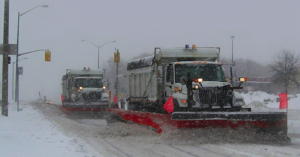 Now you can find out just where that plow is and when it might get to your street. When plows pass over a road, the colour of the road on the map changes to indicate a plow is operating in the area. As the clean-up continues, roads throughout the city will change colour until all plowing is complete.
The Burlington Plow Tracker can be found at burlington.ca/snow.
Parking During the Winter
When a Snow Event is declared (when accumulation is 7.5 cm or more), there is no parking on any city streets until after the Snow Event has been declared over. The City thanks residents for their cooperation to move their vehicles off city streets to help with snow clearing operations. Residents who park their cars on streets blocking snow removal could be faced with a $120 parking ticket or be towed.
All existing parking exemptions are invalid during Snow Events.
Snow Events and parking restrictions are announced through the City’s social media as well as through Snow Control Updates which can be found at burlington.ca/snow. Snow Control Updates can also be emailed to any resident who subscribes.
To sign up for Snow Control Updates and other important notices, go to burlington.ca/enews.
 Enrico Scalera, Director of Roads, Parks and Forestry explains” “The City’s snow clearing operations proceed on a priority system where busier roads such as Brant Street, Walkers Line, New Street and Upper Middle Road are addressed first, followed by secondary and local residential streets. Through the use of our new AVL system, we have the opportunity to increase oversight of our operations and improve the overall quality of services delivered to the residents of Burlington.” Enrico Scalera, Director of Roads, Parks and Forestry explains” “The City’s snow clearing operations proceed on a priority system where busier roads such as Brant Street, Walkers Line, New Street and Upper Middle Road are addressed first, followed by secondary and local residential streets. Through the use of our new AVL system, we have the opportunity to increase oversight of our operations and improve the overall quality of services delivered to the residents of Burlington.”
Links and Resources
Snow clearing: burlington.ca/snow
Direct link to Burlington Plow Tracker: burlington.focus511.com/

 By Pepper Parr By Pepper Parr
January 12th, 2022
BURLINGTON, ON
It has been some time since a Burlington city council came even close to bringing tears to the eyes of the Chief Planner. They themselves found the occasion quite a bit more emotional than they expected.
Well into a long day when council covered a lot of important ground City Manager Tim Commisso announced that Executive Director Heather MacDonald would be resigning. The evening would be her last to take part in a Community Planning Regulation and Mobility Standing Committee meeting.
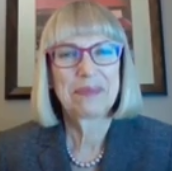 Heather MacDonald Heather joined the city shortly after the election of the current council and had to work with council members who knew next to nothing about the planning process and what was involved in a development application.
Heather became a den mother to the five new members and served as a solid source of new knowledge for Councillor Sharman who said he had learned more about planning from Heather than any other planner he had met.
The imposition of an Interim Control bylaw, something that members of council didn’t even know existed, brought development in large parts of the city to an immediate halt. It was a bylaw that could not be appealed and gave the city some breathing room to find a way to manage the development applications that were being filed.
 Heather brought her skills, experience and network to bear on the problems Burlington faced at a critical time. Handling the changes that were made to the 2018 Official Plan and working with the Region to bring that Plan into compliance with the Regional Plan was an opportunity to refine the plan and align it with the aspirations of the new council.
Heather brought her skills, experience and network to bear on the problem and in the process was able to fine tune in some situations and in others bring in substantial changes to what the 2014-2018 council had passed.
The Urban Growth Centre got moved north creating a significantly different development environment and opened up the opportunity to create the environment needed to develop in and around the GO stations that have been given new community names: Burlington Junction; Aldershot Corners and Appleby Gateway. Get used to them – those areas that may well become new municipal wards as the city goes through this growth stage that stretches out to 2051.
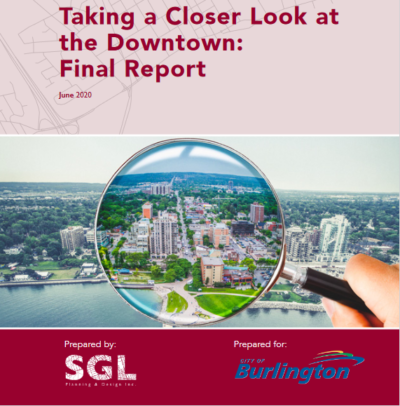 The report was a beginning of a different look at the downtown. Heather was given an authority few Chief Planners get – to sole source a consulting contract that had a cap of $600,000.
One of the things Heather did that will be a lasting legacy for the city is the number of new people she brought into the Planning department.
 MacDonald hired and nurtured dozens of planners that will serve this city well going forward. Some of the most impressive talent I have seen in 50 years of covering municipal governments now work for the city. Heather went looking for people with the skills the city needed – and she found them. This is not the place to name them – there are so many, I fear that I will miss naming some of them.
In the fullness of time their contributions to the city will become clearly evident. City Manager Commisso said he needed what Heather MacDonald brings to the table and has asked her to serve as executive lead on a project. She will be available to staff for awhile yet.
For the immediate future there is a 15 month old grandchild who is about to get a lot more attention.

 By Tom Muir By Tom Muir
January 11th, 2020
BURLINGTON, ON

These are all fabricated numbers from the dictatorship of planning at the province. They are not the product of any thinking about reality, and are not negotiable in any sense at all. All the Region does is follow the orders.
All this with no public input or involvement or process, except the six years or so of the Burlington and Region OP review and rewrites that are going to be put to waste in a wholesale policy nullification in what is looking to be a central planning basis from the Province. How this works explains itself.
The Province keeps increasing the population targets at increasing rates, with longer timelines, in the revisions to the Growth Plan and other elements of the Provincial Policy Frame. It is now spanning 30 years going to 40 years with a target of increasing Halton’s population by 500,000 or more people, essentially doubling the population.
These population targets outpace the City and Regional OP policies and development goals based on lengthy public consultation. The Growth Plan targets and policies basically amplify the populations used by developers to argue their proposals.
There are major omissions in the overall Policy Frame makeup, the context within which the several Provincial Policies are driving what we see, and development in general. They are always driving the same way as we have done in the past, like the world has not changed. In fact the context we live and decide in has changed in every respect.
I don’t think it reasonable to refer to all of the elements of the current Policy Frame as unchanged and constant mandates that have not been severely tested by COVID19, and will be by Climate Change. There is no consideration of these severe economic, public health, and environmental climate background changes and visible impacts on society, in the policy frames about development.
I say that this is not thinking about it, because it is clear that COVID19 has changed everything to do with the use and availability of space and spacing. Almost everything was closed for a time, and very much is still running at a low speed as we see many structural changes taking place, such as use, demand and supply of office space, which as an example, have large vacancies.
We have to ask about what is going to work in the new context. How are we going to get to the employment targets that are so casually just trotted out?
One piece of evidence that is emerging from the pandemic is that COVID19 prevalence is associated with overdeveloped/crowded higher density built form, transit dependence, too little green space, deficient amenity area, and other too many to mention decreased standards that are like what the mass development appeals in Burlington are about.
There is no Big Picture consideration of climate change (CC) and of COVID as a change in context. Both CC and COVID are what is known in science as “Extinction-level events” . Everything will be forced to change form and to adapt to the new reality. We are already experiencing this, but the Policy Frame ignores this fundamental background change completely.
I do not see how this disruptive change in context is being taken into account in the transportation and public transit planning aspects of the Policy Frame and Growth Plan being used and referred to in this development plan. The basic pillars of the entire policy frame and plans for future development are dependent on aspirations and assumptions about growth, transportation and mass transit. COVID19 has emptied a lot of transit vehicles and more people are driving.
As I said above, the timeline impact of the appeal is 30 to 40 years, and scope for 500,000 new people. Nothing in a path to this will be the same as our past experience, and this needs to be considered when changes in form, height, density and, really, everything we say we are planning for. Density and intensification made Toronto an epicenter. Transit dependence amplified that. This is a general feature of the disease prevalence.
I would bet that no witnesses will be giving evidence-based study and testimony on the public health aspects of urban planning, and impacts on transportation.
None of this should be tolerated.
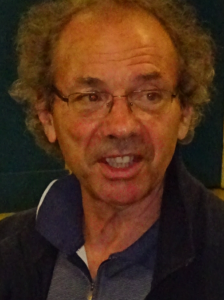 Tom Muir is an Aldershot resident who has delegated to city council on numerous occasions. A retired federal civil servant Muir likes to ski at Aspen. He can’t wait for travel restrictions to be lifted. Tom Muir is an Aldershot resident who has delegated to city council on numerous occasions. A retired federal civil servant Muir likes to ski at Aspen. He can’t wait for travel restrictions to be lifted.

 By Pepper Parr By Pepper Parr
January 11th, 2020
BURLINGTON, ON
They were called Mobility Hubs in the beginning.
Then they got technical and called then MTSAs – short for Major Transportation Services area.
Not much colour or character in any of those.
So – the planners got creative and going forward they will be called:
Burlington Junction – for what we know as the Burlington GO station
Appleby Gateway – for what we know as the Appleby GO station
Aldershot Corners – for what we know as the Aldershot GO station.
Much better – wonder what the Metrolinx people will think about the change.
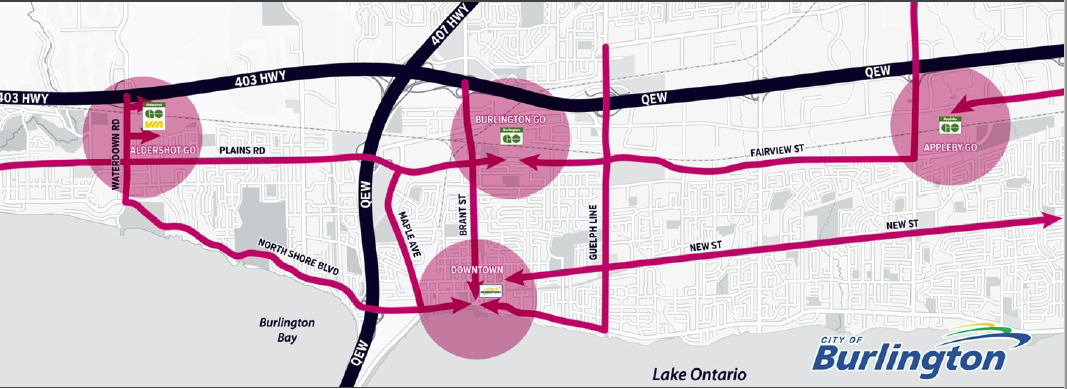 The graphic is the story of a real success. It marks the decision to move a lot of the development around the GO stations and it notes as well that this city council got rid of that hub/MTSA at the bottom. 
 By Pepper Parr By Pepper Parr
January 11th, 2022
BURLINGTON, ON
Another one of those pictures being worth a thousand words.
Council is currently debating the level of growth Burlington will have to experience based on numbers being developed at the Regional level.
Much more to tell on this story but for the moment – here is what they are looking at.


 By Rupert Walters By Rupert Walters
January 12th, 2022
BURLINGTON, ON
Online casinos are popular in Canada; it is one of the top countries with a high percentage of online players globally. In the era of the digital age, almost everything happens on the Internet. Games, sport, commerce have been digitized to accommodate and include a bigger percentage of people and to remove distance as a barrier.
 With the introduction and growth of online gambling, especially in Canada, the popularity of online gambling keeps rising. Before this age, gambling as a sport happened in land casinos. Gambling in casinos was viewed as exotic, and the most famous casinos attracted the elites. With the introduction and growth of online gambling, especially in Canada, the popularity of online gambling keeps rising.
As a result of the outright legalization of gambling in Canada, Canadians can easily play the game, win the games, and still enjoy the casino experience from the comfort of their homes.
Advantages of Playing Online Casino in Canada
Online gambling is a lucrative business and sport for players who play to win and gambling companies. Online casinos offer a diverse range of casino games, much more than regular house casinos. Players in Canada enjoy numerous features such as video poker, blackjack, slot lotteries, and live casino games.
Online casino games are safe and legal. Online casino sites that are licensed and registered are required by law to protect player information and data. Players are assured of their safety, credit card details, and password safety.
Online casinos are the best method to learn the betting game. Unlike the physical casinos where a learner plays against season players and most times loses money to the experienced player, online casinos give you a more balanced chance to learn without going bankrupt on your first tries.
With online casinos, you can play games any time of the day as it is accessible round the clock. It also includes amazing features such as toll-free support numbers, huge jackpots, welcome bonuses, and Canadian banking options.
The online gambling platform is prone to change from reviews and is always evolving based on the best info. As a result, the industry is always taking measures to create a safer, user-friendly experience for its consumer base. This has contributed greatly to online gambling thriving as a business and industry.
What Are the Canadian Government Regulations for Gambling?
Online gambling is legalized in Canada. The criminal code of Canada is a bill that involves illegal gaming and their federal charges in Canada,with the exemption of cases that are clearly stated in the bill or code. The code states that the provincial government can operate, regulate and control lotteries and online gambling. It also states the prohibition of gaming operations in Canada with some exemptions.
Online gambling laws in Canada can be regulated by each province in whatever way it deems fit. Each province is entitled to control and regulate gambling laws in its province.
 First Nations culture and dance. Gambling laws in Canada are divided into two broad categories, the First Nations law, and the provincial law. In Canada, federal laws are designed to pass online gambling regulations to the provincial government. There are, however, restrictions in some provinces.
Some local, provincial laws are difficult and restrictive, while others are flexible and simple. For example, places like Ontario and cities like Markham have restricted web-based gaming, and players experience difficulty in placing bets.
To enjoy the full experience of online betting in Canada, it is important to familiarize yourself with the local laws that regulate online gambling in whichever province you stay or are playing from.
Before an online gambling platform can operate legally, it must be licensed. The Kahnawake gaming commission is one of the licensing authorities in Canada. Once licensed, it is legal, and legality is guaranteed under Canadian federal laws.
Online casinos and gambling sites are, under the law, required to assure players’ safety. This means that players’ confidential and payment information is secure. In addition, licensed online casino sites use SSL encryption to guarantee and ensure data safety from hackers and fraudulent acts.
Players are also advised to avoid online casinos that are not licensed. Any form of fraud or danger you might encounter will be to your detriment. Offshore online casinos are prohibited by law and can lead to criminal charges.
Requirements to Own a Licensed Online Casino in Canada.
The requirements needed to establish and receive a license to operate as an online casino include the following:
The license can be revoked or declined when these requirements are not met.
Online casinos are on the rise in Canada, it is huge, and it keeps getting bigger. It is played for fun, entertainment, and as a sport. Online casinos should not be perceived as full-time jobs or a source of income, and gambling should not be done with personal saving money. Players must be well informed on the laws that govern this sport in Canada before playing.

 By Pepper Parr By Pepper Parr
January 10th, 2022
BURLINGTON, ON
Part 2 of a 2 part feature on the level of citizen satisfaction on how the city is delivering services
Engagement has been a prime concern for the members of the current city council. Mayor Meed Ward has made engagement her signature skill set.
She at one point said she had 17 different ways to communicate with the voters of the city.
All are one-way traffic lanes – from the Mayor to whoever is listening.
 Mayor Marianne Meed Ward engaging with the citizens of Itabashi, Japan, during a tour of one of Burlington’s sister city. Meed Ward prides herself on her training as a journalist – she used to frequently make mention of how important local media is – yet – she has not once held an open media event where questions could be asked directly and follow up questions put to her when she might appear to be avoiding an issue.
None of this is to suggest that Meed Ward has been a failure as a Mayor. She understood the importance of moving the Urban Growth Centre from the downtown core and pushing it north and closer to the GO stations where the high rise growth is going to take place.
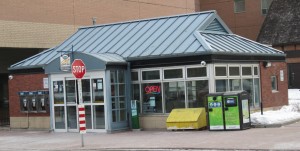 The Rick Goldring Council went along with the Metrolinx decision to designate the bus terminals an MTSA – Major Transit Service Area. And – she made sure that a tiny bus terminal, smaller than many kitchens lost the designation it had as an MTSA – Major Transportation Service Area. That designation is what made it possible for a development to soar 26 stories on a lot that was far too small for that particular development.
In the survey done by a reputable organization 755 Burlington residents were randomly selected and interviewed using either a residential landline or cell phone number.
The 2019 community survey is the first time that interviews/surveys were conducted using cell phone numbers, this is an important distinction to make as more people are forgoing landlines in favour of cell phones. The Community Survey was also replicated online (from September 13 to October 15) the City’s decision-making about projects and services is reflective of the voice of a majority of residents, with two major differences; 1) it was open call where anyone registered to the Get Involved Burlington platform could take the survey and 2) the sample size was much smaller (234 online versus 755 facilitated by MDB Insight).
When it came to measuring satisfaction on engagement we saw the following:
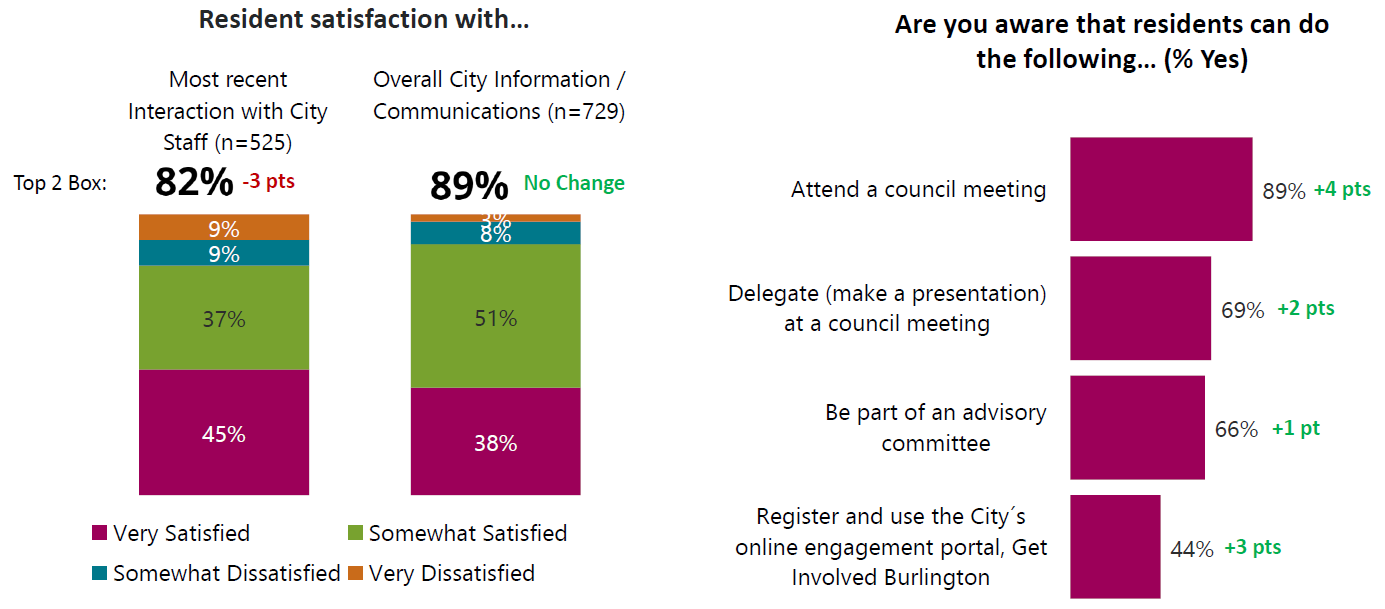

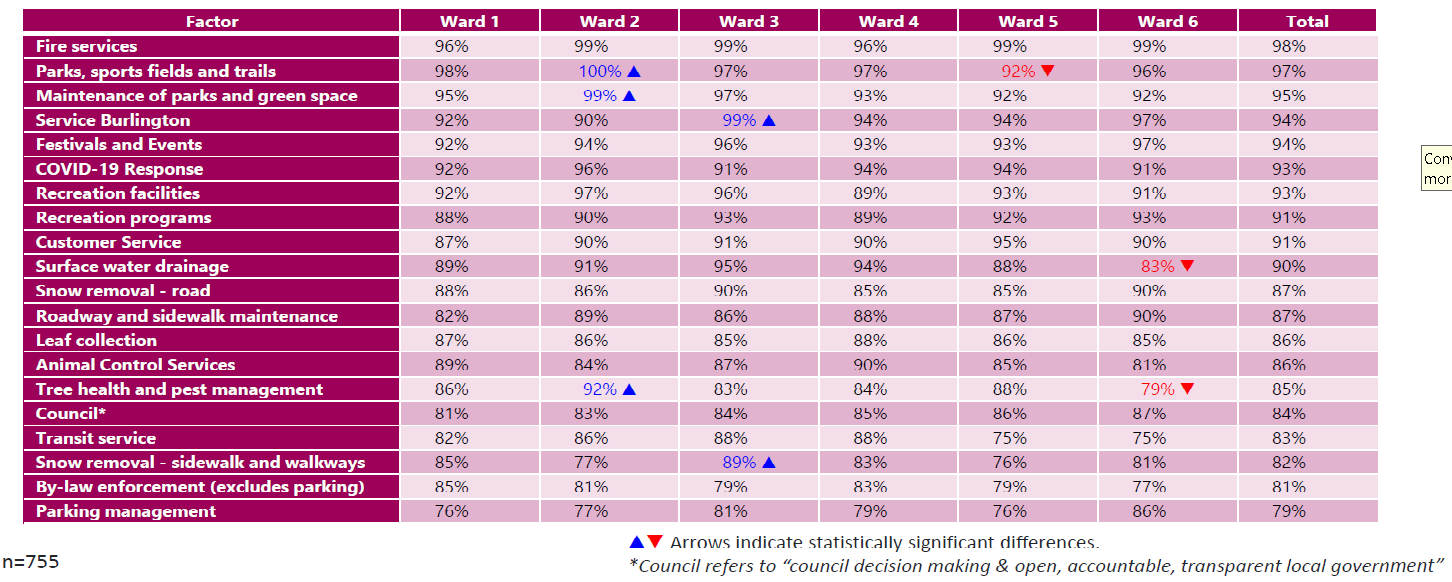
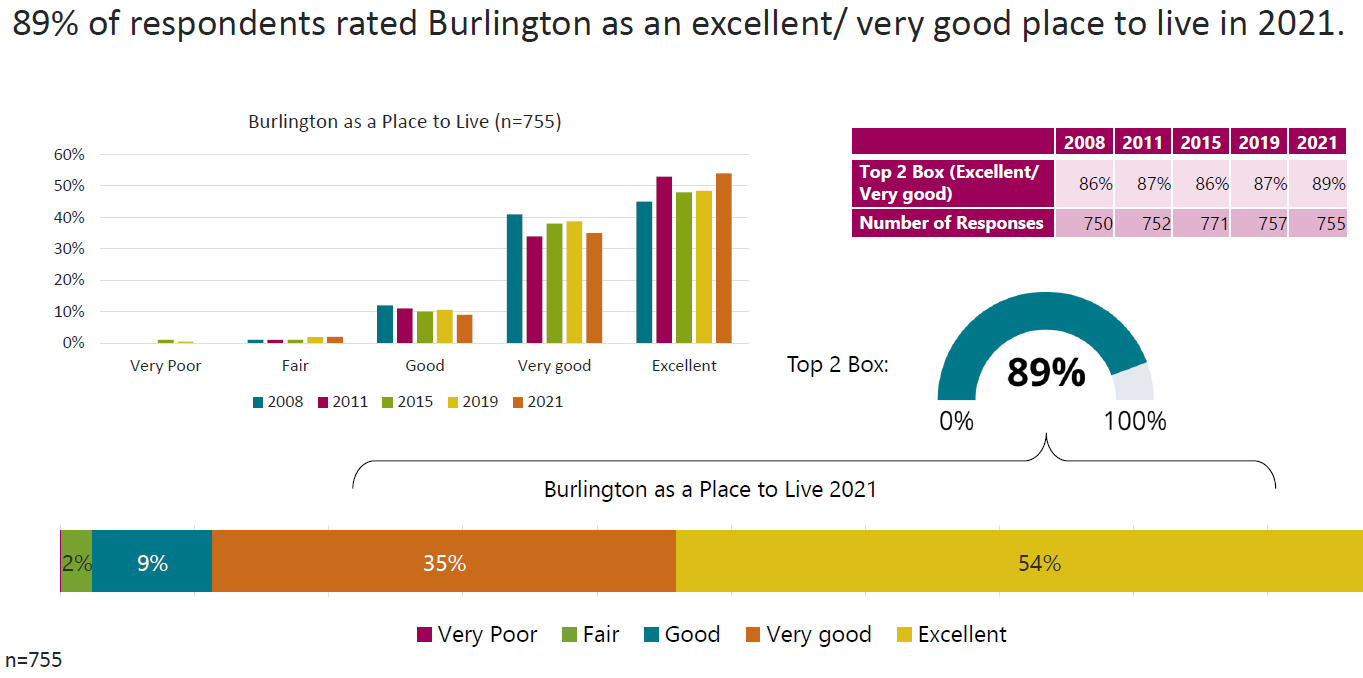
One of the graphics asks where people got their news.

In 2017 the Gazette was on that list. Someone somewhere removed our name from the list of news sources people in Burlington use.
Our numbers have grown every year during the ten years we have been publishing. Thought you would want to know that.
Part 1 of the series

 By Pepper Parr By Pepper Parr
January 10th, 2020
BURLINGTON, ON
Council is going to hear a report this week on the The Waterfront Hotel Planning Study that was undertaken to comprehensively plan the waterfront site at 2020 Lakeshore Road and guide the landowner in its redevelopment.
Given that the site has been referred to as Ground Zero for Burlington an in-depth study made a lot of sense.
The Waterfront Hotel Planning Study will inform an implementing Official Plan Amendment. Once approved, that amendment will form part of the City’s Official Plan and provide a strategic framework to guide the redevelopment of the subject property.
 Notice the space between the southern part of the dotted red line and the edge of the lake. Who owns that property? Is it part of the hotel land or is it controlled by Conservation Halton? That’s an important question. The Study began in early 2017 and included three public meetings/community workshops (a total of six sessions) and two community surveys. In November 2017, an update on the status and progress of the study was presented to Council at the Planning and Development Committee Meeting. This community and stakeholder engagement phase first explored eight design ideas, which were then refined to three preliminary design concepts, and then two emerging concepts.
As a result of additional community and stakeholder input in early 2018, a staff report was brought to the Planning and Development Committee in June 2018. At that time, a set of key policy directions to guide the development of a final concept were endorsed by City Council. These key policy directions were organized around the design principles of Land Use and Built Form, Public Realm, and Mobility and Access.
In mid-2018 the Study was placed on hold due to other various priorities in the Community Planning Department such as the New Official Plan process and for staff to re-visit the Study workplan while considering the set of key policy directions endorsed by Council in June 2018.
While all the futzing and putzing was going on the developer beavered away at doing the design work and taking part in a pre-consultation meeting required to submit a development application.
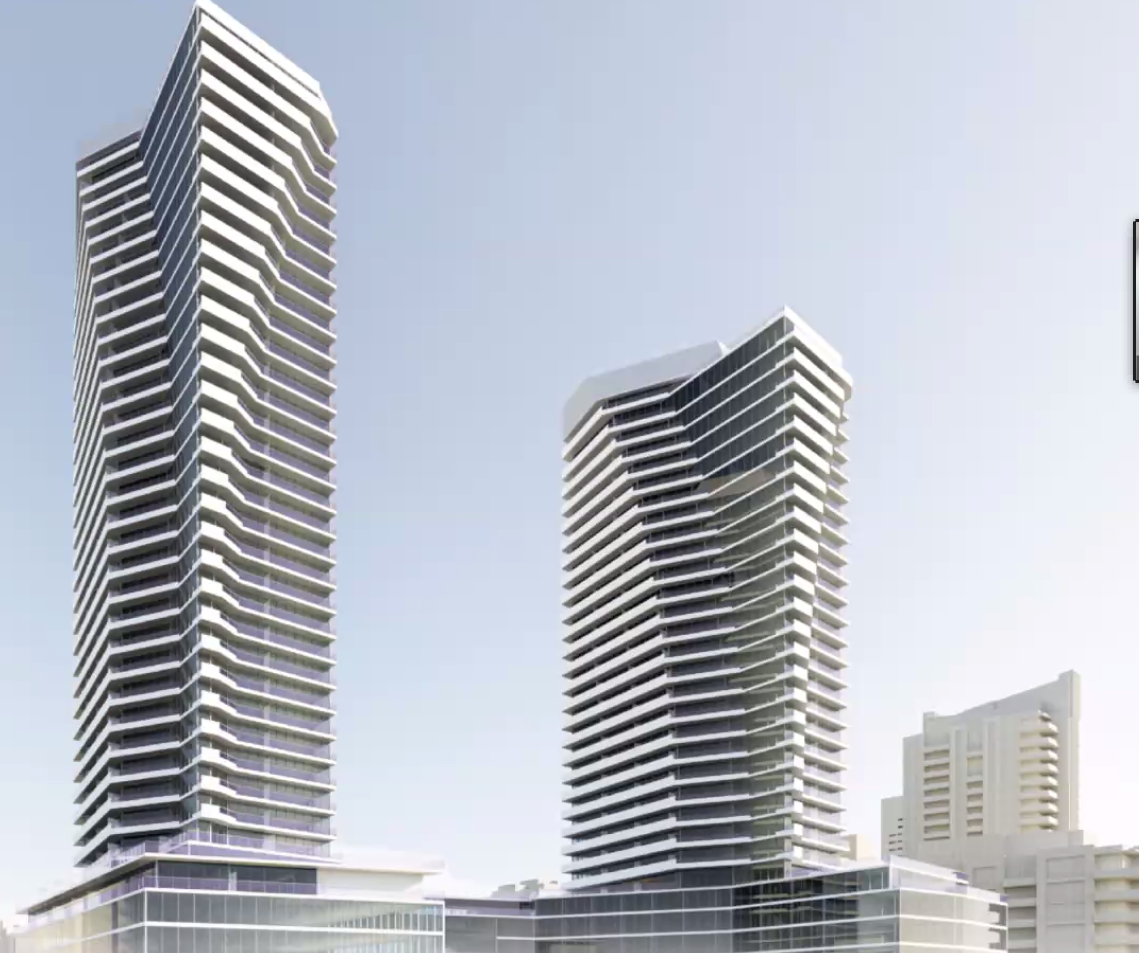 The design is world class – the architects have made excellent use of the different views that will be available. That application was submitted, but deemed to be incomplete by the planning department.
So what is the point of returning to the Study – the developer has wind in his sails and is on his way.
The Staff report makes mention of “height not to exceed three (3) storeys within 20 metres of Brant Street and Lakeshore Road and eleven (11) storeys adjacent to John Street and beyond 20 metres of Brant Street and Lakeshore Road” while the developer presents a plan for two towers that are very close to the southern edge of Lakeshore Road and soar 35 storeys high. The second tower is just 30 stories high. Both sit on a five storey podium.
The design of the buildings is superb, these are very smart looking buildings that would be a delight to live in. The plan puts them in the wrong place. One wag described the development as “out of proportion; out of place and should be outa here”
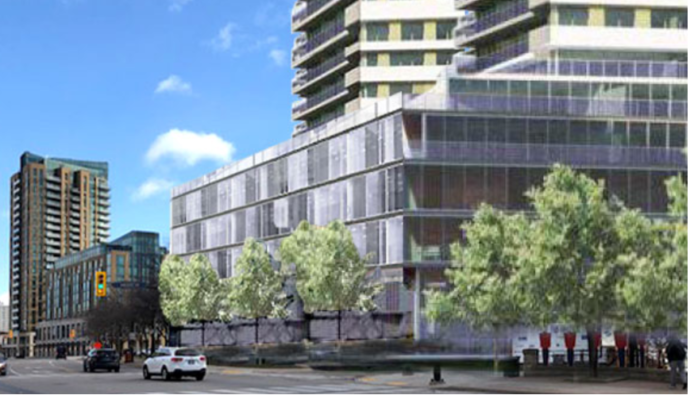 The northern edge of the site is very close to the edge of Lakeshore Road. The five storey podium will loom over the street – with no view to the lake. The entrance to the east end of Spencer Smith Park will be through an opening in the podium. The surrounding context of the Waterfront Hotel Planning Study Area including changes to the northeast corner made through the scoped re-examination of the New Official Plan Project, will be considered in the development of the preferred concept for the Subject Property.
This will also include a review of the key policy directions endorsed by Council in June 2018, including the amended key policy direction #8 which was modified by Council to include the following language in bold text:
 Enhance the Brant Street view corridor to frame views to the Brant Street Pier, and require a significant building setback from the west property line and define and consider a building setback from the thin red line and maximize the new and enhanced publicly accessible green/open space. Enhance the Brant Street view corridor to frame views to the Brant Street Pier, and require a significant building setback from the west property line and define and consider a building setback from the thin red line and maximize the new and enhanced publicly accessible green/open space.
That “thin red line” concept came from the Plan B, a group of citizens that believe something much better can be done with the hotel site.
 It was a solid idea but the city planners found a way to get rid of the idea. At the January 23, 2018 Planning and Development Committee a council motion was carried to modify the block shown at the northeast corner of Brant Street and Lakeshore Road located in the proposed Cannery Precinct (22-storeys) to the Downtown Core Precinct with a maximum building height of 17-storeys including community benefits.
As a result of Council’s modification, the basis for the expanded public realm at the corner and enhanced setback limit was eliminated.
On April 26, 2018 City Council adopted a new Burlington Official Plan. On December 4, 2018, the Region of Halton issued a Notice of Non-Conformity to the City, which had the effect of extending the Region’s review process until such time as the Region determined that the non-conformity was rectified. While collaborating extensively with Regional staff on the issues of non-conformity the City undertook the scoped re-examination of the adopted Official Plan. This process took place while the Waterfront Hotel Planning Study was on hold.
Through the scoped re-examination of the New Official Plan Project in 2019-2020, the adopted Official Plan policies for the Downtown were studied. As part of that work the north-east corner of Brant Street and Lakeshore Road was revisited and was included within the Brant Main Street Precinct. The purpose of this precinct was to serve as a unique retail destination within the Downtown and city-wide.
The precinct provides a wide range of policies to guide development within the precinct. Specifically, related to built form, this precinct requires height not to exceed three (3) storeys within 20 metres of Brant Street and Lakeshore Road and eleven (11) storeys adjacent to John Street and beyond 20 metres of Brant Street and Lakeshore Road. In November 2020 the Region of Halton approved Burlington’s New Official Plan, which is currently under appeal.
The Subject Property was not included in the scoped re-examination of the New Official Plan Project and the new Official Plan did not change the existing land use designation and permitted building height for the Waterfront Hotel property located at 2020 Lakeshore Road.
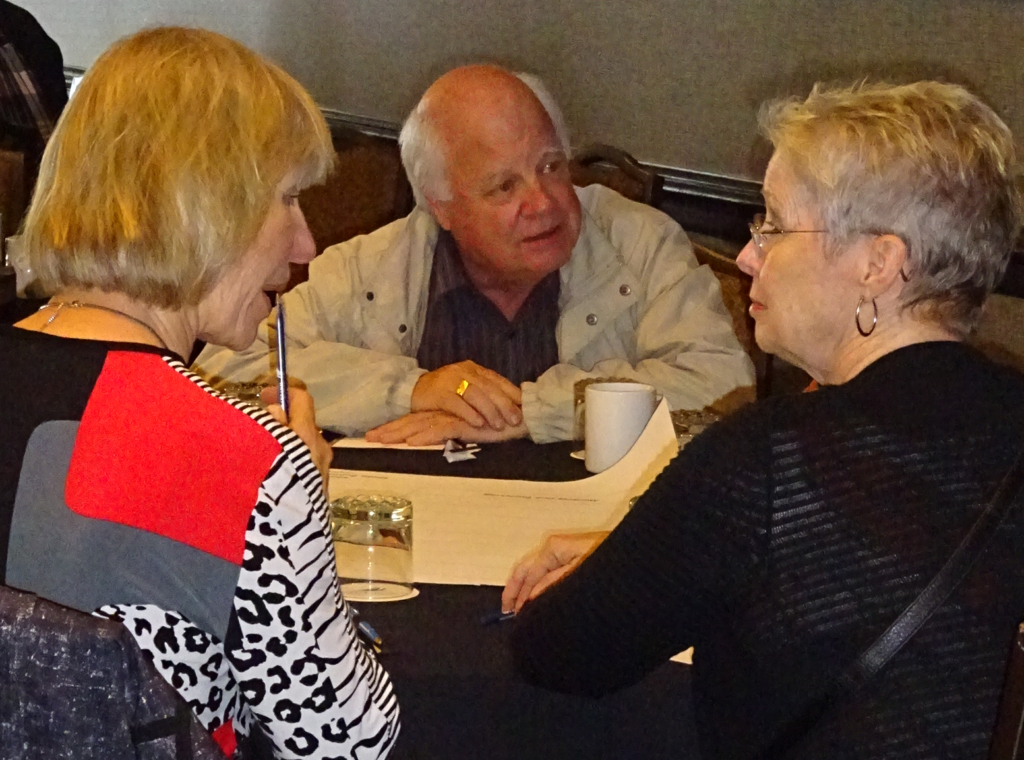 Former city Councillor John Taylor in discussion with Linda Davies and Dee Dee Davies during one of the six public sessions that were held shortly after this Council was elected. The Gazette was asked to leave the room, at the instructions of the Mayor, when the conversation between the stakeholders was taking place. Next Steps
With the re-examination of the New Official Plan (Taking a Closer Look at the Downtown) Project completed, approval of the new Official Plan (under appeal), as well as the Minster of Municipal Affairs and Housing’s approval, with modifications, of the Regional Official Plan Amendment 48 it is the appropriate time to resume the Waterfront Hotel Planning Study.
City staff with support from the project consultant, The Planning Partnership, the group that is leading the consultation process will resume the workplan where it left off in 2018 to complete the study. The work is anticipated to take 16-17 weeks and will be completed within the original project budget. The resumption of the study will build upon and advance the previous work and community input to-date to develop a final preferred concept.
There is a much better solution on what can be done with the hotel site.
A small group is working at building public support for a different look at the waterfront hotel site that includes possible land swaps and building a new city hall on the property; something that would be four or five storeys high and include a purpose built Art Gallery.
Burlington can do better than the application before the Planning department. There are limits on what developers should be able to do.
This is a story that is going to be around for some time. It is your city.
Related news stories:
More on Plan B
Some ideas on what is possible

 By Pepper Parr By Pepper Parr
January 10th, 2021
BURLINGTON, ON
Part 1 of a two part report on how satisfied with citizens are with the services the city provides
Council got off to a fast start this morning. Just as soon as they confirmed that there was a quorum they went into a Closed Session. There were three different matters that had to do with litigation and the public seldom gets to listen to any of that stuff.
Rory Nisan was chairing the CSSRA Standing Committee – he advised that there would be another break in the proceedings for a different closed session later in the day.
The meeting today was virtual virtual. The practice up until this point has been to have the Chair and the Clerk in Council Chambers. This time Nisan got to stay home and run the show from his residence. He was not wearing sweatpants or pyjamas.
On the agenda was a report on how well the city is doing on citizen engagement. A report from MBD consulting, that had a price tag of $29,000 + was presented.
Since 1998, the City of Burlington has conducted community survey since 1998 to uncover resident satisfaction. The surveys typically happen every 2-4 years, the most recent surveys were in 2008, 2011, 2015, 2019 and 2021. The survey provides the opportunity for bench marking and to monitor progress of community measures over time with the goal of continuous improvement. In addition to resident satisfaction, the last three community surveys (2015, 2019 and 2021) included asking residents questions regarding communications and engagement with the City.
One of the questions asked related to taxes.

There are additional graphics further along in this article.
The 2021 community survey was conducted using Computer Aided Telephone
Interviews where respondents were randomly selected from the city’s population using a mix of both residential landlines and cell phone numbers. The goal was to complete 750 interviews/surveys, with 125 completed interviews/surveys per ward. The total reached was 755 completed interviews/surveys with a margin of error of +/-3.6% with a 95% confidence interval.
The interviews/surveys were conducted between September 13 to October 18 and it took on average 18 minutes to complete. Responses were weighted based on the population by age and ward. Two items that are important to note one, that satisfaction of city services results were analyzed using a priority matrix that compares performance, room for improvement and the derived importance of each service (a measure which represents the level to which each service is related to overall satisfaction) and two a combination of both randomly selected Burlington cellular and landlines were included in order to obtain a variety of responses.
These were the issues that people were most concerned about
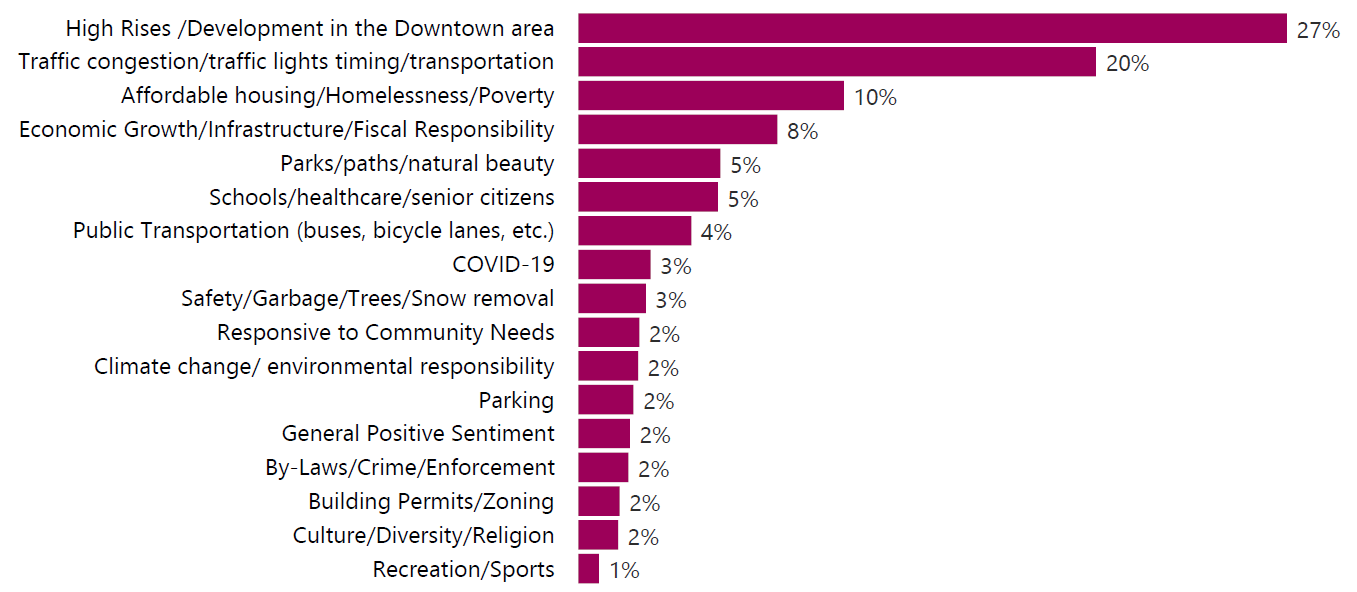
Levels of satisfaction with the services that are being provided

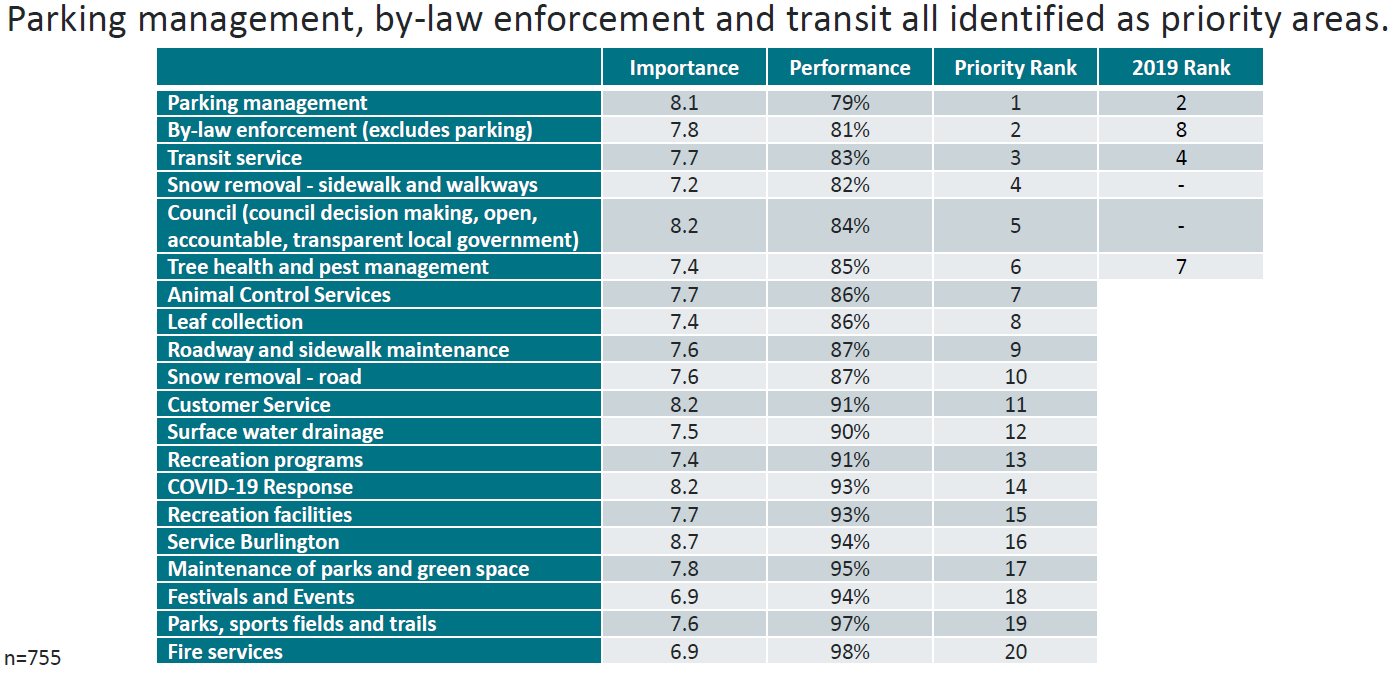

Overall, the results of the survey turned out highly positive across several measures.

 By Staff By Staff
January 7th, 2022
BURLINGTON, ON
The Public Health people have said an outbreak of Covid19 has been declared on Unit 6 South 200 (6S200) at Joseph Brant Hospital (JBH) after three patients tested positive.
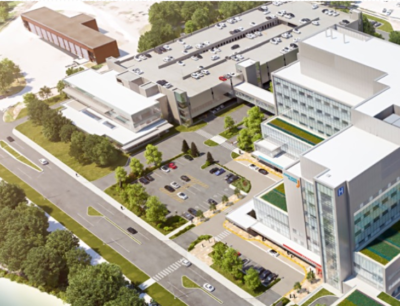 All appropriate precautions have been taken to ensure the safety of patients, Essential Care Providers (ECPs), staff and physicians. All appropriate precautions have been taken to ensure the safety of patients, Essential Care Providers (ECPs), staff and physicians.
Joseph Brant Hospital’s Infection Prevention and Control team and Employee Health Services are ensuring all patients on the unit, along with staff and physicians who have been or may have been exposed, are being contacted, monitored, tested as required and self-isolating in keeping with Public Health guidelines. Patients on the unit are in isolation as of January 6 and have been instructed to continue the 10-day self-isolation when discharged from hospital.
A number of enhanced safety measures are in place to prevent the spread of COVID-19 and ensure the safety of patients, staff and physicians. This includes closing 6S200 to new patient admissions except for COVID-19 positive patients. In addition, ECPs are no longer permitted to enter the unit except under exceptional circumstances in consultation with the patient’s care team. Patients can still connect with their loved ones by telephone and video – both telephone and WiFi are available at no cost.
JBH is monitoring the situation closely and will continue to work closely with Halton Region Public Health to bring a safe end to the outbreak as soon as possible. Patients or loved ones who have questions or concerns can contact a member of the JBH Patient Relations team at 905-632-3737 ext. 4949 or by email patientrelations@josephbranthospital.ca.

 By Staff By Staff
January 7th, 2022
BURLINGTON, ON
City will host another COVID-19 Telephone Town Hall on Jan. 19 at 6:30 p.m.
The City of Burlington will host its eleventh COVID-19 telephone town hall event.
The event provides an opportunity for the community to hear how this latest Covid19 variant is impacting us and a chance to ask questions about the on-going COVID-19 pandemic and how it is impacting city programs and services.
The event will be hosted by Mayor Marianne Meed Ward, who will be joined by a panel of local leaders, including representatives from Joseph Brant Hospital, to help answer residents’ questions.
How to Participate
Residents who would like to participate in the town hall can do so in the following ways:
Register in advance: Burlington residential phone numbers will be randomly selected to be part of the telephone town hall. Residents who would like to be added to the telephone call list can email getinvolved@burlington.ca by noon on Jan. 18, 2022.
If you registered for any of the previous town halls, you are not required to register your phone number a second time. If you wish to have your phone number removed from the call list, please email getinvolved@burlington.ca by noon on Jan. 18, 2022.
Join by telephone: Anyone who does not receive a telephone invitation can call 1-800-759-5308 just before 6:30 p.m. on Wednesday, Jan. 19 to join the town hall.
For those individuals calling in, please be advised more than one attempt may be required due to the high volume of traffic on the phone lines. If the first call does not connect, please hang up and dial the 1-800 number again.
Listen to audio: Live audio from the Jan. 19 town hall will be broadcast on YourTV, channel 700 on Cogeco and on the YourTV Halton YouTube page.
Once the call begins, a moderator will provide participants with instructions for how to submit their questions to the leadership panel.
A recording and transcript of the town hall will be posted online after Jan. 19

 By Pepper Parr By Pepper Parr
January 7th, 2022
BURLINGTON, ON
Word from a usually reliable source is that Regional Chair Gary Carr is not going to run for re-election in October.
 Gary Carr as a goal tender. Gary and his wife moved to Burlington recently and are apparently enjoying being in the city. Previously they were living in a semi-rural setting in Milton
Carr has done a good job at the Region. He was a good MPP and an excellent Speaker in the Legislature. He was a pretty good goalie when he played hockey.
The talk amongst the political set is that Tom Adams, an Oakville Councillor is looking at the job. The Region could do a lot worse.
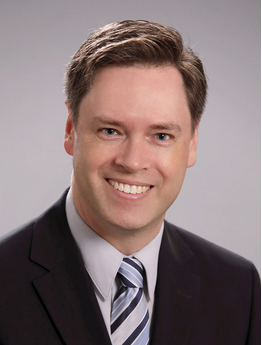 Tom Adams – Oakville and Regional Councillor He is the longest continuous serving Chair of Halton’s Planning and Public Works Committee as well as the longest serving Chair of Oakville’s Budget Committee. In these positions, Councillor Adams has worked to protect natural lands, build and renew infrastructure and strengthen Oakville’s strong finances.
Adams is young, articulate and well focused when he takes on a task. Good on detail as well

 By Staff By Staff
January 5th, 2022
BURLINGTON, ON
 On Tuesday January 4, 2022 at approximately 7:15 PM the Halton Regional Police Service responded to a 66 year old pedestrian who was struck by a motor vehicle on Lakeshore Road near Goodram Road On Tuesday January 4, 2022 at approximately 7:15 PM the Halton Regional Police Service responded to a 66 year old pedestrian who was struck by a motor vehicle on Lakeshore Road near Goodram Road
Paramedics transported the pedestrian to Joseph Brant Hospital for emergency treatment.
Unfortunately the pedestrian succumbed to his injuries and was pronounced deceased by medical staff. The driver remained on scene and is cooperating with the police investigation.
The Collision Reconstruction Unit has taken carriage of the investigation. Any witnesses who have not yet spoken to police are asked to call 905-825-4747 ext: 5065.

|
|
 By Staff
By Staff Starting Monday, Jan. 17, 2022, the Downtown Terminal opening hours will be
Starting Monday, Jan. 17, 2022, the Downtown Terminal opening hours will be












 By Paul Sharman
By Paul Sharman



 Keep in mind, this plan follows the 2018 election when the people of Burlington spoke out clearly that they do not wish to see “over intensification” of their hometown. It is not what anyone wanted.
Keep in mind, this plan follows the 2018 election when the people of Burlington spoke out clearly that they do not wish to see “over intensification” of their hometown. It is not what anyone wanted. By Pepper Parr
By Pepper Parr






 By Staff
By Staff By Mike Collins-Williams
By Mike Collins-Williams There is no silver bullet solution to the housing crisis. We all need to work together – The private sector, the non-profit sector and all three levels of government. I strongly believe that this is the most important opportunity to develop the effective partnerships we all need to successfully address the housing crisis.
There is no silver bullet solution to the housing crisis. We all need to work together – The private sector, the non-profit sector and all three levels of government. I strongly believe that this is the most important opportunity to develop the effective partnerships we all need to successfully address the housing crisis. Mike Collins-Williams is the CEO of West End Home Builders Association (WEHBA) . He is a Registered Professional Planner and is a member of the Burlington’s Housing Strategy Task Force
Mike Collins-Williams is the CEO of West End Home Builders Association (WEHBA) . He is a Registered Professional Planner and is a member of the Burlington’s Housing Strategy Task Force  By Don Fletcher
By Don Fletcher


 By Staff
By Staff

 Enrico Scalera, Director of Roads, Parks and Forestry explains” “The City’s snow clearing operations proceed on a priority system where busier roads such as Brant Street, Walkers Line, New Street and Upper Middle Road are addressed first, followed by secondary and local residential streets. Through the use of our new AVL system, we have the opportunity to increase oversight of our operations and improve the overall quality of services delivered to the residents of Burlington.”
Enrico Scalera, Director of Roads, Parks and Forestry explains” “The City’s snow clearing operations proceed on a priority system where busier roads such as Brant Street, Walkers Line, New Street and Upper Middle Road are addressed first, followed by secondary and local residential streets. Through the use of our new AVL system, we have the opportunity to increase oversight of our operations and improve the overall quality of services delivered to the residents of Burlington.”



 By Tom Muir
By Tom Muir
 Tom Muir is an Aldershot resident who has delegated to city council on numerous occasions. A retired federal civil servant Muir likes to ski at Aspen. He can’t wait for travel restrictions to be lifted.
Tom Muir is an Aldershot resident who has delegated to city council on numerous occasions. A retired federal civil servant Muir likes to ski at Aspen. He can’t wait for travel restrictions to be lifted.
 By Rupert Walters
By Rupert Walters 












 Enhance the Brant Street view corridor to frame views to the Brant Street Pier, and require a significant building setback from the west property line and define and consider a building setback from the thin red line and maximize the new and enhanced publicly accessible green/open space.
Enhance the Brant Street view corridor to frame views to the Brant Street Pier, and require a significant building setback from the west property line and define and consider a building setback from the thin red line and maximize the new and enhanced publicly accessible green/open space.





 All appropriate precautions have been taken to ensure the safety of patients, Essential Care Providers (ECPs), staff and physicians.
All appropriate precautions have been taken to ensure the safety of patients, Essential Care Providers (ECPs), staff and physicians.

 By Staff
By Staff On Tuesday January 4, 2022 at approximately 7:15 PM the Halton Regional Police Service responded to a 66 year old pedestrian who was struck by a motor vehicle on Lakeshore Road near Goodram Road
On Tuesday January 4, 2022 at approximately 7:15 PM the Halton Regional Police Service responded to a 66 year old pedestrian who was struck by a motor vehicle on Lakeshore Road near Goodram Road



